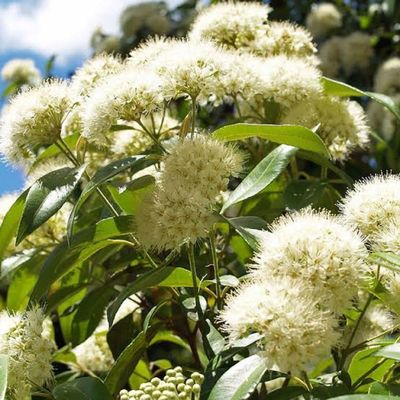By Beatrice Hawkins
I’ve recently had reason to find out some information on the uses and types of edible Australian native plants.
I’ve known of a number of them over the years but never had need to source them for use in cooking until recently – lemon myrtle, pepper berry, wattle seed, quandongs, finger limes, kakadu plums, macadamia nuts and the list goes on!
Quondongs I have picked and made into jam and would love to be able to have access to a supply of them when they are in season. They are really a lovely flavour and my special treat to me for many years at the Sydney Royal Show was a Quandong ice-cream – delightful! At the moment I have a jar of quandong glaze in my pantry ready to use for a special occasion.
Lemon Myrtle infused olive oil is something I have used on special occasions but have not at this stage used wattle seeds.
Finger limes I have growing in a pot but as yet I have not had any fruit from the tree. I have had these delightful little balls of flavour used as a garnish on a lime flavoured pannacotta. It is a shrub I would recommend to anyone interested in something a little different and who doesn’t mind spikes – it is very thorny!
On researching the Lemon Myrtle tree (Backhousia citriodora) it was suggested that it is an ideal small tree to plant in a medium-sized garden and can be kept to a good size with regular pruning. It was also suggested that it is suitable for growing in a large pot and as it is subject to frost damage, that is possibly the best way to grow it in our area. You could then shift it to a protected spot for the winter. The flavour is quite strongly lemon and flavours things well.
While looking for information on lemon myrtle I also found Desert Limes (citrus glauca). This is a tree that I have seen growing in the western areas of both Queensland and NSW. It is a true citrus but was considered too acidic to be used as a table fruit by the early settlers. These days it is recognised as being very high in Vitamins C and E and antioxidants and has 10 times the Calcium and folate of blueberries.
The leaves are an attractive food source for native and domestic animals but as a young tree is very thorny as a form of natural protection. It is interesting though, that once the tree reaches a height where kangaroos cannot graze the leaves, it stops producing thorns!
It flowers in August and the fruit is ready to use about November. It is the quickest citrus of all to set fruit after flowering but will shed its fruit if there isn’t enough soil moisture. It tolerates extreme heat and cold, (+45 to -12 degrees) salinity and a wide range of soil types. It grows over a wide range of country from Longreach down to Dubbo and inland to Quorm in the Flinders Ranges of SA.
The fruit is very small and round, only about 2cm diameter and 1-3 grams in weight. You would need to pick a lot to make much marmalade! The fruit is either picked by hand or by commercial harvesters of the type used for olives. The fruit needs to be kept cool as it is picked, then cleaned and frozen. It is traded as frozen fruit and thaws well keeping its shape, taste and texture.
As they take about 10 years to bear fruit commercially their use has been limited but they can be grafted and the grafted tree will bear after 3 years. If you can find a grafted one to grow treat it as you would a normal citrus, grow it in full sun, keep it moist but don’t over water, and don’t prune it for the first 5 years. It is the only citrus that is a xerophyte which means that it can lose all its leaves in a dry time and live through the green on its stems – isn’t nature wonderful!
I have been asked lately if I knew of anyone with a good astringent persimmon tree. My friend has been trying unsuccessfully for some time to buy one and would like to get a cutting if someone had a tree. So if you do and wouldn’t mind giving a cutting, please contact me and I’ll pass the message on. (ph 0488 470 706).







